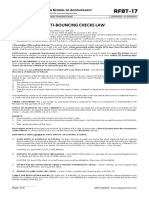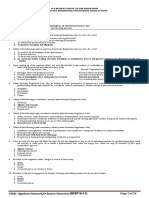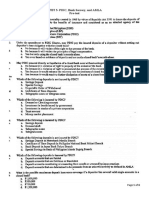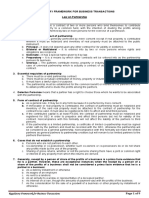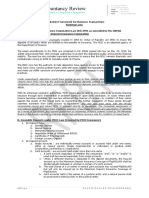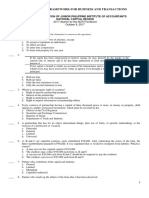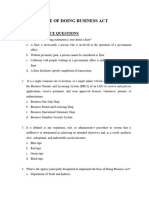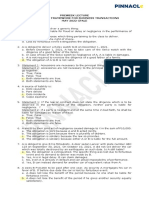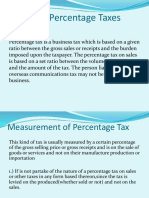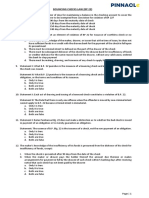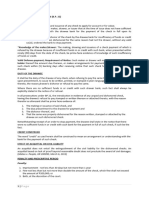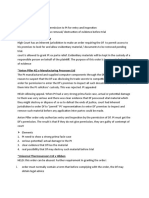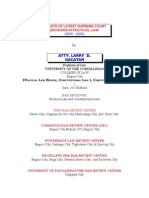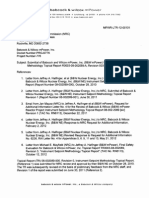RFBT-17 (Anti-Bouncing Checks Law)
RFBT-17 (Anti-Bouncing Checks Law)
Uploaded by
reynanciacatherinemaeCopyright:
Available Formats
RFBT-17 (Anti-Bouncing Checks Law)
RFBT-17 (Anti-Bouncing Checks Law)
Uploaded by
reynanciacatherinemaeCopyright
Available Formats
Share this document
Did you find this document useful?
Is this content inappropriate?
Copyright:
Available Formats
RFBT-17 (Anti-Bouncing Checks Law)
RFBT-17 (Anti-Bouncing Checks Law)
Uploaded by
reynanciacatherinemaeCopyright:
Available Formats
ReSA - THE REVIEW SCHOOL OF ACCOUNTANCY
CPA Review Batch 47 May 2024 CPA Licensure Examination
RFBT-17
REGULATORY FRAMEWORK for BUSINESS TRANSACTIONS J. DOMINGO N. SORIANO
ANTI-BOUNCING CHECKS LAW
ELEMENTS OF VIOLATION of Bouncing Checks Law (BP 22):
1. The making, drawing, and issuance of any check to apply for account or for value;
2. The knowledge* of the maker, drawer, or issuer that at the time of issue he does not have sufficient funds in or credit with
the drawee bank for the payment of the check in full upon its presentment; and
3. (a) The subsequent dishonor of the check by the drawee bank for insufficiency of funds or credit or (b) would have been
dishonored for the same reason had not the drawer, without any valid cause, ordered the bank to stop payment.
*Knowledge of the maker/drawer: The making, drawing and issuance of a check payment of which is refused by the drawee
because of insufficient funds in or credit with such bank, when presented within ninety (90) days from the date of the
check, shall be prima facie evidence of knowledge of such insufficiency of funds or credit.
Valid Defense – payment; Requirement of Notice: Such maker or drawer will not be liable if he pays the holder thereof
the amount due thereon, or makes arrangements for payment in full by the drawee of such check within (5) banking days
after receiving notice that such check has not been paid by the drawee.
DUTY OF THE DRAWEE: It shall be the duty of the drawee of any check, when refusing to pay the same to the holder thereof
upon presentment, to cause to be written, printed, or stamped in plain language thereon, or attached thereto, the
reason for drawee's dishonor or refusal to pay the same.
Where there are no sufficient funds in or credit with such drawee bank, such fact shall always be explicitly stated in
the notice of dishonor or refusal.
In all prosecutions under BP Blg 22, the introduction in evidence of any unpaid and dishonored check, having the drawee's
refusal to pay stamped or written thereon or attached thereto, with the reason therefor as aforesaid, shall be prima facie
evidence of:
1. The making or issuance of said check, and
2. The due presentment to the drawee for payment and
3. The dishonor thereof, and
4. That the same was properly dishonored for the reason written, stamped or attached by the drawee on such dishonored
check.
Notwithstanding receipt of an order to stop payment, the drawee shall state in the notice that there were no sufficient funds in
or credit with such bank for the payment in full of such check, if such be the fact.
CREDIT CONSTRUED: The word "credit" as used herein shall be construed to mean an arrangement or understanding with
the bank for the payment of such check.
EFFECT OF ACQUITTAL ON CIVIL LIABILITY: An acquittal does not entail the extinguishment of the civil liability for the
dishonored checks. An acquittal based on lack of proof beyond reasonable doubt does not preclude the award of civil damages.
(Mateo v. People, GR 200090, March 6, 2013)
PENALTY:
1. Imprisonment – not less than 30 days but not more than 1 year
2. Fine – not less than but not more than double the amount of the check, which fine shall not exceed the amount of P200,000;
or
3. Both, at the discretion of the court.
Prescriptive period: Prescriptive period of BP 22 Violation of B.P. Blg. 22 prescribes in four (4) years from the commission
of the offense or, if the same be not known at the time, from the discovery. thereof
DIFFERENCE WITH ESTAFA BY POST-DATING OR ISSUING A CHECK:
a. GOOD FAITH IS A DEFENSE IN ESTAFA: So that when the accused who issued the check believing that he would be
able to make the corresponding deposit, informed the complainant, when he sensed that he could not make the deposit,
not to present the check to the bank for cancellation, he could not be held liable for Estafa. (See People vs. Villapando) By
informing the payee, there is no deceit. (Firestone Tire and Rubber Co. of the Philippines vs. Ines Chavez)
In BP Blg. 22, good faith is NOT a valid defense.
b. PAYMENT OF A PRE-EXISTING OBLIGATION – NO ESTAFA: If the check is in payment of a pre-existing obligation there
is no deceit and hence, the crime of Estafa cannot exist.
In BP Blg. 22, even if the check is issued to pay a pre-existing obligation, there may still be liability.
c. ESTAFA MAY BE COMMITTED BY MERELY ISSUING A WORTHLESS CHECK – unlike in BP Blg. 22 which requires that
the accused BOTH drew and issued the check.
d. PERIOD TO MAKE GOOD THE CHECK – is only 3 days in estafa, but 5 banking days in BP Blg. 22.
LIABLE FOR BOTH ESTAFA AND BP 22: Under Sec. 5 of BP Blg. 22, the prosecution thereof shall be without prejudice to any
liability for violation of any provision of the RPC. It is now well settled that a single act can give rise to Estafa and at the same
time to violation of BP Blg. 22.
Page 1 of 2 0915-2303213 resacpareview@gmail.com
ReSA – THE REVIEW SCHOOL OF ACCOUNTANCY
ANTI-BOUNCING CHECKS LAW RFBT-17
MULTIPLE CHOICE QUESTIONS
1. Knowledge of insufficiency of funds in BP Blg 22 would be presumed if the check was presented within __ days from the
date of the check
A. 30
B. 60
C. 90
D. 120
2. The drawer and issuer of the worthless check will not be liable under BP Blg. 22 if he pays the holder or makes arrangements
for the payment in full by the drawee of the amount of the check within ___________ after receiving notice that such check
has not been paid by the drawee:
A. 3 calendar days
B. 3 banking days
C. 5 calendar days
D. 5 banking days
3. The stamp of the drawee written on the dishonored check, with the reason therefor, shall be prima facie evidence of the
following, except:
A. Making or issuance of the check
B. Due presentment to the drawee for payment
C. The dishonor of the check
D. None of the choices is an exception
4. This shall be construed to mean an arrangement or understanding with the bank for the payment of the subject check
under BP Blg 22:
A. Arrangement
B. Contract
C. Credit
D. Loan
5. Violation of BP Blg. 22 may subject the accused to a fine not to exceed:
A. P100,000
B. P200,000
C. P500,000
D. P1,000,000
6. Good faith is a valid defense in:
A. Estafa by postdating or issuing a worthless check
B. BP Blg 22
C. Both Estafa and BP Blg 22
D. Neither Estafa nor BP Blg 22
7. Neal Caffrey issued a check to Peter Burke as payment for goods purchased by the former from the latter. Peter presented
the check 30 days from the date of the check and the same was dishonored due to insufficiency of funds. Assuming the
notice requirement has already been complied with, Neal
A. Can be guilty of violating the Anti-Bouncing Checks Law
B. Can be guilty of Estafa for issuing a worthless check
C. Can be guilty of violating both the Anti-Bouncing Checks Law and Estafa for issuing a worthless check
D. Did not commit any crime
8. Neal Caffrey issued a check to Peter Burke which induced the latter to deliver goods in exchange for the check. Peter
presented the check 30 days from the date of the check and the same was dishonored due to insufficiency of funds.
Assuming the notice requirement has already been complied with, Neal
A. Can be guilty of violating the Anti-Bouncing Checks Law
B. Can be guilty of Estafa for issuing a worthless check
C. Can be guilty of violating both the Anti-Bouncing Checks Law and Estafa for issuing a worthless check
D. Did not commit any crime
9. In the violation of the Anti-Bouncing Checks Law, the accused must be:
A. The issuer
B. The drawer
C. Both the issuer and drawer
D. Either the issuer or the drawer
10. In the violation of Estafa involving worthless checks, the accused must be:
A. The issuer
B. The drawer
C. Both the issuer and drawer
D. Either the issuer or the drawer
1. C 6. A
2. D 7. A
3. D 8. C
4. C 9. C
5. B 10. D
Page 2 of 2 0915-2303213 resacpareview@gmail.com
You might also like
- RFBT-05 (Partnerships)Document12 pagesRFBT-05 (Partnerships)VKVCPlays100% (1)
- RFBT-09 (Banking Laws)Document13 pagesRFBT-09 (Banking Laws)Erlinda Molina100% (1)
- RFBT-MCQ-03-Law On PartnershipDocument10 pagesRFBT-MCQ-03-Law On PartnershipmarinNo ratings yet
- 05 - Anti-Bouncing Checks LawDocument2 pages05 - Anti-Bouncing Checks Lawxara mizpah100% (1)
- General Banking Law - Quizzer With AnswersDocument9 pagesGeneral Banking Law - Quizzer With AnswersJust ForNo ratings yet
- Credit TransactionsDocument8 pagesCredit TransactionsLoyce Grace MorenteNo ratings yet
- Taxation Cup SeriesDocument5 pagesTaxation Cup SeriesGlaiza Atillo Batuto Orgino100% (1)
- Personal and Professional Ethics: Unit IDocument21 pagesPersonal and Professional Ethics: Unit IJagadeesh Putturu100% (1)
- RFBT RC ExamDocument9 pagesRFBT RC Examjeralyn juditNo ratings yet
- Resa Anti Bouncing Checks LawDocument2 pagesResa Anti Bouncing Checks LawArielle D.No ratings yet
- Bouncing LawDocument3 pagesBouncing LawALYSSA MAE ABAAGNo ratings yet
- RFBT - Final Preboard Cpar 92Document17 pagesRFBT - Final Preboard Cpar 92joyhhazelNo ratings yet
- Law On Cooperative HandoutsDocument8 pagesLaw On Cooperative Handoutsxara mizpahNo ratings yet
- The Professional CPA Review SchoolDocument23 pagesThe Professional CPA Review SchoolGray JavierNo ratings yet
- Batas Pambasa 22 Review MCQsDocument3 pagesBatas Pambasa 22 Review MCQsNicky ChrisNo ratings yet
- RFBT Preweek (B44)Document16 pagesRFBT Preweek (B44)LeiNo ratings yet
- Resa Credit TransDocument7 pagesResa Credit TransArielle D.No ratings yet
- Regulatory Framework For Business Transactions: ST NDDocument9 pagesRegulatory Framework For Business Transactions: ST NDMark Domingo MendozaNo ratings yet
- RFBT-04 (Insurance)Document4 pagesRFBT-04 (Insurance)Dizon Ropalito P.No ratings yet
- RFBT - Other Special Law MCQs SolutionsDocument25 pagesRFBT - Other Special Law MCQs SolutionsEarl Justine FerrerNo ratings yet
- RFBT 5-PDIC, Bank Secrecy, and AMLA Pre-TestDocument6 pagesRFBT 5-PDIC, Bank Secrecy, and AMLA Pre-TestCharles D. FloresNo ratings yet
- Test Bank Law On Sales - CompressDocument7 pagesTest Bank Law On Sales - CompressViky Rose EballeNo ratings yet
- RFBT-05 (Partnerships)Document14 pagesRFBT-05 (Partnerships)Gup KnwNo ratings yet
- Regulatory Framework For Business Transaction-SIR SALVADocument248 pagesRegulatory Framework For Business Transaction-SIR SALVASofia SanchezNo ratings yet
- Regulatory Framework For Business Transactions: Page 1 of 9Document9 pagesRegulatory Framework For Business Transactions: Page 1 of 9DanicaNo ratings yet
- Pre Board Examination RFBT Batch 2 PDFDocument18 pagesPre Board Examination RFBT Batch 2 PDFMikasa MikasaNo ratings yet
- RFBT Review NotesDocument14 pagesRFBT Review NotesKJReyes_No ratings yet
- RFBT 3-Law On Credit Transactions Pre-TestDocument5 pagesRFBT 3-Law On Credit Transactions Pre-TestCharles D. FloresNo ratings yet
- RFBT Final PreboardDocument11 pagesRFBT Final PreboardCovi LokuNo ratings yet
- CTDI Final Pre-Board Special Laws Only PDFDocument4 pagesCTDI Final Pre-Board Special Laws Only PDFPatricia Marie MercaderNo ratings yet
- RFBT03-19 - Banking LawsDocument41 pagesRFBT03-19 - Banking LawsWes100% (1)
- AMLA QuizDocument7 pagesAMLA QuizZarina BartolayNo ratings yet
- RFBT 13 Banking LawsDocument9 pagesRFBT 13 Banking LawsKayceelin PasionNo ratings yet
- RFBT 03 SalesDocument10 pagesRFBT 03 SalesShiela Marie Sta AnaNo ratings yet
- FL RFBTDocument13 pagesFL RFBTalyssagd100% (1)
- RFBT.3408 Ipl Eca Dpa PDFDocument14 pagesRFBT.3408 Ipl Eca Dpa PDFMonica GarciaNo ratings yet
- RFBT-16 (Financial Rehabilitation & Insolvency Act)Document8 pagesRFBT-16 (Financial Rehabilitation & Insolvency Act)Alliah Mae ArbastoNo ratings yet
- Nfjpia Frontliners RFBT 2019Document19 pagesNfjpia Frontliners RFBT 2019Risalyn BiongNo ratings yet
- Quiz Maceda LawDocument3 pagesQuiz Maceda LawchmaburdeosNo ratings yet
- Batangas CPA Review Center: A. SalesDocument10 pagesBatangas CPA Review Center: A. SalesZyrelle DelgadoNo ratings yet
- Law003 Ease of Doing Business Act QuestionsDocument5 pagesLaw003 Ease of Doing Business Act Questionskgandamarket.jeassel100% (1)
- Week 15 - Data Privacy ActDocument5 pagesWeek 15 - Data Privacy ActJevanie CastroverdeNo ratings yet
- Resa ContractsDocument12 pagesResa ContractsArielle D.No ratings yet
- RFBT-13 (Banking Laws)Document10 pagesRFBT-13 (Banking Laws)Alliah Mae ArbastoNo ratings yet
- Bp. 22 Quizzer With AnswersDocument2 pagesBp. 22 Quizzer With AnswersPrincesNo ratings yet
- MCQ FRIA No Ans - For PrintingDocument8 pagesMCQ FRIA No Ans - For PrintingWilsonNo ratings yet
- Negotiable Instruments Law and Anti-Bouncing Checks Law: Atty. Nicko Soriano, CpaDocument22 pagesNegotiable Instruments Law and Anti-Bouncing Checks Law: Atty. Nicko Soriano, CpaMedyNo ratings yet
- Pinnacle RFBTDocument24 pagesPinnacle RFBTMiguel ManagoNo ratings yet
- Strategic Cost Management Budgeting Quizzer: (ICMA, Adapted)Document7 pagesStrategic Cost Management Budgeting Quizzer: (ICMA, Adapted)LumingNo ratings yet
- GROUP 3 Bank Secrecy and Unclaimed Deposit QuestionnaireDocument3 pagesGROUP 3 Bank Secrecy and Unclaimed Deposit QuestionnaireMary Joy Morallon Calagui100% (1)
- RFBT Business Law Reviewer ChallengeDocument7 pagesRFBT Business Law Reviewer ChallengeRegine YbañezNo ratings yet
- Report of Law1 - Other Percentage TaxDocument16 pagesReport of Law1 - Other Percentage TaxJonalyn Maraña-ManuelNo ratings yet
- The Law On Partnership: Business LawsDocument4 pagesThe Law On Partnership: Business LawsLFGS FinalsNo ratings yet
- RFBT MCQ Class No. 3172Document51 pagesRFBT MCQ Class No. 3172hyunsuk fhebieNo ratings yet
- Resa PARTNERSHIPDocument12 pagesResa PARTNERSHIPArielle D.No ratings yet
- RFBT - Chapter 4 - Truth in Lending ActDocument3 pagesRFBT - Chapter 4 - Truth in Lending Actlaythejoylunas21No ratings yet
- Quiz 2 in TaxDocument3 pagesQuiz 2 in TaxAnne Camille AlfonsoNo ratings yet
- Managerial Economics QuestionnairesDocument26 pagesManagerial Economics QuestionnairesClyde SaladagaNo ratings yet
- Estate Tax Mulitiple ChoiceDocument7 pagesEstate Tax Mulitiple ChoiceMina ValenciaNo ratings yet
- RFBT BP 22 QuestionnairesDocument3 pagesRFBT BP 22 QuestionnairesXela Mae Bigornia100% (1)
- Anti-Bouncing Checks LawDocument2 pagesAnti-Bouncing Checks LawPamela Daneth AgondezNo ratings yet
- Anti Bouncing Checks Law Batas Pambansa Blg. 22Document1 pageAnti Bouncing Checks Law Batas Pambansa Blg. 22MarkNo ratings yet
- Anton Piller Order: Halsbury's Laws of MalaysiaDocument5 pagesAnton Piller Order: Halsbury's Laws of MalaysiatiaNo ratings yet
- Law Web Basic Principles For Determining Suit For PartitionDocument35 pagesLaw Web Basic Principles For Determining Suit For Partitionravi_bhateja_2No ratings yet
- LeaseDocument8 pagesLeaseABDOULIENo ratings yet
- Konkan Railway Recruiting Medical OfficerDocument6 pagesKonkan Railway Recruiting Medical OfficerCareerNotifications.comNo ratings yet
- Railways Act 1991 (Accident and Offences and PenaltiesDocument20 pagesRailways Act 1991 (Accident and Offences and PenaltiesMuhammad SallehuddinNo ratings yet
- Edexcel - M2 - Revision SheetDocument9 pagesEdexcel - M2 - Revision SheetsembeNo ratings yet
- CAM EncodedDocument2 pagesCAM EncodedChaNo ratings yet
- 403 Study Notes 1 and 2 ChapterDocument52 pages403 Study Notes 1 and 2 Chapterpranamya bhavsarNo ratings yet
- 001 - 130830 - COMPLAINT - FH Case 2 (Case 13-cv-61881-RNS)Document35 pages001 - 130830 - COMPLAINT - FH Case 2 (Case 13-cv-61881-RNS)Vikas GuptaNo ratings yet
- Delos Santos Michael Jacob 12 JAVA FormsDocument6 pagesDelos Santos Michael Jacob 12 JAVA FormsJacob Delos SantosNo ratings yet
- How To Talk To A Police OfficerDocument6 pagesHow To Talk To A Police OfficerJohn Lange100% (1)
- Taal, Batangas: The Heritage TownDocument36 pagesTaal, Batangas: The Heritage TownDa JeNo ratings yet
- Rubik S Brand v. Flambeau - ComplaintDocument36 pagesRubik S Brand v. Flambeau - ComplaintSarah BursteinNo ratings yet
- Hindu Coparcenary Family LawDocument10 pagesHindu Coparcenary Family LawRHEANo ratings yet
- Apec Operations ManualDocument5 pagesApec Operations ManualJazzmin CalinoNo ratings yet
- Chinhoyi University of TechnologyDocument16 pagesChinhoyi University of TechnologyronaldNo ratings yet
- Digests of Supreme Court Decisions in Political Law (2006-2009)Document317 pagesDigests of Supreme Court Decisions in Political Law (2006-2009)JimiKarateNo ratings yet
- Newton - S Laws of MotionDocument23 pagesNewton - S Laws of MotionAndrei AlidoNo ratings yet
- FIFA 558 CommentaryDocument1 pageFIFA 558 Commentarysantiago palaciosNo ratings yet
- Def of Shariah & FiqhDocument25 pagesDef of Shariah & FiqhHakim AliNo ratings yet
- GM Safety Camera Handbook v2.0Document35 pagesGM Safety Camera Handbook v2.0IainRobertsNo ratings yet
- ISA Set Point MethadologyDocument115 pagesISA Set Point Methadologyjainrakeshj4987No ratings yet
- Obligation and ContractDocument41 pagesObligation and ContractJustine CuadranteNo ratings yet
- New Era University Barcelleno, Jobelle L. College of Law JD Non-Thesis S.Y. 2020-2021Document20 pagesNew Era University Barcelleno, Jobelle L. College of Law JD Non-Thesis S.Y. 2020-2021jobelle barcellanoNo ratings yet
- Nandganj Sihori Sugar Co LTD Vs Badri Nath Dixit and Ors On 24 AprilDocument8 pagesNandganj Sihori Sugar Co LTD Vs Badri Nath Dixit and Ors On 24 AprilPratistha PriyadarshiNo ratings yet
- Pasay City vs. Court of First Instance, G.R. No. L-32162, September 28, 1984Document6 pagesPasay City vs. Court of First Instance, G.R. No. L-32162, September 28, 1984roigtcNo ratings yet
- Public Accountants and Auditors Act 27 - 12Document12 pagesPublic Accountants and Auditors Act 27 - 12Anesu Nathan ChiwaridzoNo ratings yet
- Villanueva vs. CA - Amado vs. SalvadorDocument8 pagesVillanueva vs. CA - Amado vs. SalvadorMariaAyraCelinaBatacanNo ratings yet









